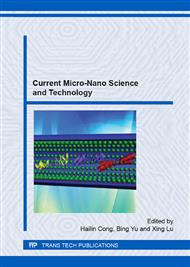[1]
R. W. Boyd, Nonlinear Optics, Academic Press, New York, (1992).
Google Scholar
[2]
M. Blanchard-Desce, J. -M. Lehn, M. Barzoukas, C. Runser, A. Fort, I. Ledoux, J. Zyss, Nonlinear Opt. 10 (1995) 23.
DOI: 10.1109/cleoe.1994.636401
Google Scholar
[3]
P. N. Prasad, D. J. Williams, Wiley, New York, (1991).
Google Scholar
[4]
D. A. Parthenopoulos, P. M. Rentzepis, Science 245 (1989) 843.
Google Scholar
[5]
D. N. Christodoulides, I. C. Khoo, G. J. Salsmo, G. I. Stegeman, E. W. Van Stryland, Adv. Opt. Photonics, 2 (2010) 60.
Google Scholar
[6]
G.S. He, J.D. Bhawalkar, C.F. Zhao, P.N. Prasad, Appl. Phys. Lett. 67 (1995) 2433.
Google Scholar
[7]
W. Zhou, S. M. Kuebler, K. L. Braun, T. Yu, J. K. Cammack, C. K. Ober, J. W. Perry, S. R. Marder, Science 296 (2002) 1106.
Google Scholar
[8]
S. Kawata, H. -B. Sun, T. Tanaka, K. Takada, Nature 412 (2001) 697.
Google Scholar
[9]
V. Y. Prinz, V. A. Seleznev, A. K. Gutakovsky, A. V. Chekhovsky, V. V. Preobrazhenskii, M. A. Putyato, T. A. Gavrilova, Physica E 6 (2000) 828.
DOI: 10.1016/s1386-9477(99)00249-0
Google Scholar
[10]
P. X. Gao, Y. Ding, W. J. Mai, W. L. Hughes, C. S. Lao, Z. L. Wang, Science 309 (2005)1700.
Google Scholar
[11]
W. Denk, J. H. Strickler, W.W. Webb, Science 248 (1990) 73.
Google Scholar
[12]
G. S. He, G. C. Xu, P. N. Prasad, B. A. Reinhardt, J. C. Bhatt, R. McKellar, A. G. Dillard, Opt. Lett. 20 (1995) 43.
Google Scholar
[13]
M. Calvete, G. Y. Yang, M. Hanack, Synth. Met. 141 (2004) 231.
Google Scholar
[14]
J. D. Bhawalkar, N. D. Kumar, C. F. Zhao, P. N. Prasad, J. Clin. Laser. Med. Surg. 5 (1997) 201.
Google Scholar
[15]
J. Svensson, N. Antu, N. Vainorius, B. M. Borg, L. E. Wernersson, Nano Lett. 13(2013) 1380.
Google Scholar
[16]
V. A. Margulis, T. A. Sizikova, Phys. B 245 (1998) 173.
Google Scholar
[17]
D. -S. Wu, W. -D. Cheng, H. Zhang, X. -D. Li, Y. -Z. Lan, D. -G. Chen, Y. -J. Gong, Y. -C. Zhang, Phys. Rev. B 68(2003)125402.
Google Scholar
[18]
D. Xiao, F. A. Bulat, W. Yang, D. N. Beratan, Nano lett. 8 (2008) 2814.
Google Scholar
[19]
H. -L. Xu, R. -L. Zhong, S. -L. Sun, Z. -M Su, J. Phys. Chem. C. 115 (2011)16340.
Google Scholar
[20]
H. -L. Xu, Z. -R. Li, D. Wu, F. Ma, Z. -J. Li, J. Phys. Chem. C. 113 (2009) 4984.
Google Scholar
[21]
R. Li, X. Wang, Z. Ji, B. Sun, H. Zhang, C. H. Chang, S. Lin, H. Meng, Y. -P. Liao, M. Wang, Z. Li, A. A. Hwang, T. -B. Song, R. Xu, Y. Yang, J. I. Zink, A. E. Nel, T. Xia, ACS NANO. 7 (2013) 2352.
DOI: 10.1021/nn305567s
Google Scholar
[22]
O. Loboda, R. Zaleśny, A. Avramopoulos, J. -M. Luis, B. Kirtman, N. Tagmatarchis, H. Reis, M. G. Papadopoulos, J. Phys. Chem. A 113 (2009) 1159.
DOI: 10.1021/jp808234x
Google Scholar


